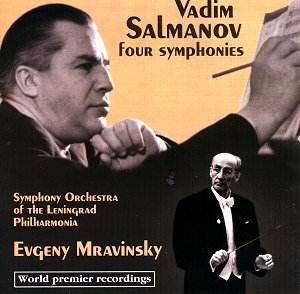Salmanov Reference
http://home.wanadoo.nl/ovar/salmanov.htm
The Russian composer
Vadim Nikolayevich Salmanov was born
on 4 November 1912 in St. Petersburg
and died there on 27 February 1978.
After piano studies with his father
he took theory lessons from Akimenko
then moved to the Leningrad Conservatory
where from 1936 until 1941 his compositions
lessons were taken with Mikhail Gnessin.
He joined the staff of the Conservatory’s
composition department in 1947 and remained
there in various capacities until his
death. Music had not always been the
most natural choice for him. He pursued
a career in geology up until 1936.
Salmanov's four symphonies
are each about thirty minutes long.
The four symphonies are represented
here by recordings taken from concert
performances; in many cases presumably
the concert premieres. In each case
the symphony was premiered by the Leningrad
Philharmonic conducted by Evgeny Mravinsky.
The First Symphony:
The opening is reminiscent of the music
for the Teutonic knights in Prokofiev's
Alexander Nevsky mixed with hushed
and etiolated mystery - to return in
the second movement - and lyrical inspirations
reminiscent of Miaskovsky's Fifth and
Sixth Symphonies. Its finale has one
of those scuttling, conspiratorial tense
chases part recalling Bruckner's Romantic
but at 00.46 it soon picks up on
the cavalry charge élan of Miaskovsky.
Here is a symphony not immune from rodomontade
(III 2:03) but clearly more in sympathy
with people like Boiko in the USSR and
George Lloyd in the UK than with true
originals like Shostakovich. The sound
is about 46 years old but apart from
a certain warbly quality is quite acceptable.
The echt Russian brass is evident in
the trumpets (III 4:56).
Three years later and
we get the Second Symphony which
opens in plaintive melancholy with flute,
clarinet and oboe, chilly if not bleak.
The second movement Summons of Nature
is packed with fast-darting detail
recalling a Prokofiev scherzo ballet
movement. Pealing stratospheric violins
trade gestures with minatory brass the
national identity of which is never
in doubt (IV 3:17).
As many years separate
the Third and Second symphonies
as divide the first two. However Salmanov's
four movement Third flirts with a medley
of dodecaphony and tonality. The posturing
of the first movement is unconvincing
but the modest Andante with its
sighing dissonances is more substantial
fare. There is a scarifying goblins'
scherzo in the shape of the allegro
vivace. Salmanov is often better
with gentle canorial ideas. With a Bergian
tinge this lyricism returns for the
Andante non troppo finale which
ends ominously. The Cold War had perhaps
taken its toll. For all that Salmanov
was seen as a loyal apparatchik and
has been bracketed with Khrennikov this
symphony ends without staged heroics
and fluttering banners.
His Fourth last
symphony came in 1977. It has been dubbed
by Salmanov researcher Mark Aranovsky,
a ‘farewell symphony’. Salmanov died
at the age of 66, one year later but
was present at the premiere. Aranovsky
speaks of 'its understated beauty, woven
from the same delicate colours as the
Leningrad sky during a summer sunset.'
Across three movements, of which the
first is almost as long as the other
two put together, Salmanov presents
three contrasted portraits. The second
movement Marciale is a knockabout
romp rife with toytown fanfares and
scathing Shostakovichian assaults. It's
an enigmatic presence when flanked by
what seem to be two musing eclogues
alive with touching soloistic gestures
from woodwind and solo violin. In the
final andante this reflective
material is matched up to strivingly
impassioned music at times torn by the
strife we hear in the first movement
of Shostakovich 6. However it is in
the cool Miaskovskian elegiac birdsong
of the flute at 5:42 that we glimpse
what is I think the real Salmanov.
These recordings are
far from hi-fi but are of fair to middling
broadcast quality given their provenance.
If you enjoy exploration there are rewarding
works here. Of the four only the Third
strikes me as lame and ill-sorted. The
Fourth fascinates in its elegiac outer
movements; the breathing of the violins
at 8:44 in the finale remains a fine
inspiration.
It's a pity that the
liner-notes tells us so little about
Salmanov. While these may be world premiere
recordings this is not the first time
they have been issued.
Salmanov may have thumped
the tub at times but his symphonies
were more often rounded with a curve
into serenity than a thundering bombastic
call-to-arms.
Rob Barnett


